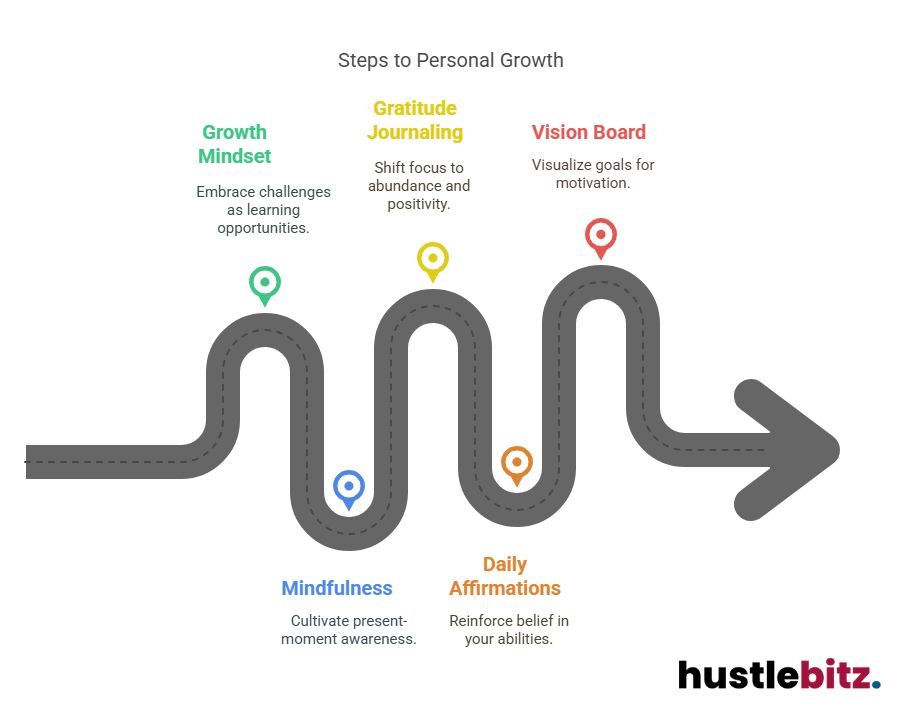Developing a success mindset requires a shift in thinking to cultivate resilience and personal growth. This involves identifying and overcoming negative thought patterns such as self-doubt and perfectionism. Embracing positive thinking enhances motivation and strengthens emotional intelligence. Techniques for reframing thoughts include mindfulness practices, gratitude journaling, and self-compassion, all aimed at viewing challenges as opportunities. Visualization and affirmation practices are also effective in aligning your mindset with your goals. By engaging with these strategies, you pave the way for achieving success and embracing a more fulfilling life, leading to insights you might find enlightening.
Key Takeaways
- Embrace a growth mindset by viewing challenges as opportunities for learning and personal development.
- Practice mindfulness to cultivate present-moment awareness and reduce negative thought patterns.
- Utilize gratitude journaling to shift focus from scarcity to abundance, enhancing overall positivity.
- Implement daily affirmations to counteract self-doubt and reinforce belief in your abilities.
- Create a vision board to visualize your goals, keeping your aspirations front and center for motivation.

Understanding the Success Mindset

The success mindset is characterized by a belief in one’s ability to grow, overcome obstacles, and achieve goals through persistence and adaptability. This mindset is critical for cultivating essential success traits, such as resilience and determination. Individuals with a growth mindset understand that their abilities can be developed through dedication and hard work, which encourages lifelong learning and continuous improvement.
Resilience building is a core component of the success mindset. By viewing challenges as opportunities for growth, individuals learn to embrace failures rather than fear them. This shift in perspective not only enhances self-efficacy—the belief in one’s capabilities—but also strengthens motivation sources. When faced with setbacks, those with a success mindset remain focused on goal setting and finding alternative paths to achievement.
Overcoming obstacles becomes a structured process when individuals prioritize their goals effectively and celebrate achievements along the way. Recognizing and acknowledging small victories fosters a positive feedback loop that fuels ongoing motivation. Additionally, the practice of reflecting on past experiences, both positive and negative, reinforces the importance of resilience and adaptability in navigating life’s challenges.
Identifying Negative Thought Patterns

Recognizing and addressing negative thought patterns is essential for fostering a success mindset, as these thoughts can significantly hinder personal growth and goal achievement. One common barrier is self-doubt triggers, which can stem from fear avoidance and lead to a paralysis of action. Individuals may find themselves ensnared in perfectionism pitfalls, where the desire for flawless execution prevents them from taking necessary risks.
Another pervasive issue is comparison syndrome, where individuals measure their achievements against others, cultivating limiting beliefs about their own potential. This negative self-talk can create a scarcity mindset, fostering feelings of inadequacy and reinforcing the idea that success is unattainable. Procrastination habits often emerge from these negative thoughts, where avoidance becomes a coping mechanism to escape perceived failure.
Additionally, a victim mentality can prevent individuals from taking responsibility for their actions, leading to blame shifting. This mindset not only impedes accountability but also stifles growth, as it shifts focus away from constructive solutions.
Recognizing these patterns is the first step in transforming them. By identifying the triggers and acknowledging their impact, individuals can begin to dismantle the barriers that obstruct their path to success. Understanding these negative thought patterns empowers individuals to reframe their perspectives, paving the way for more productive and empowering beliefs that support their goals and aspirations.
The Power of Positive Thinking
Harnessing the power of positive thinking can significantly enhance resilience and motivation, enabling individuals to pursue their goals with renewed vigor and optimism. Central to this concept is positive psychology, which emphasizes the cultivation of strengths and virtues that foster well-being. By adopting a growth mindset, individuals learn to view challenges as opportunities for development, enhancing their capacity to overcome obstacles.
Self-affirmation techniques can bolster this mindset, allowing individuals to recognize their inherent worth and capabilities. This recognition, combined with an optimism bias, encourages a forward-thinking perspective that fuels motivation. Resilience training further supports this endeavor, equipping individuals with strategies to rebound from setbacks and maintain focus on their aspirations.
Incorporating gratitude practice into daily routines can also amplify positive thinking. By acknowledging and appreciating the positive aspects of life, individuals enhance their emotional intelligence and overall happiness. Constructive feedback plays a crucial role in this process; it allows for cognitive restructuring, whereby individuals reinterpret challenges and criticism as valuable insights for growth.
Mindfulness meditation serves as a powerful tool to cultivate awareness and acceptance of one’s thoughts and emotions, promoting a balanced state of mind. By fostering an environment of positivity and self-compassion, individuals can develop a robust framework for success.
Ultimately, embracing the power of positive thinking is not merely a feel-good sentiment; it is a strategic approach that can lead to tangible outcomes and lasting fulfillment in one’s personal and professional life.
Techniques for Reframing Thoughts

Reframing thoughts involves shifting one’s perspective to view challenges as opportunities for growth, thereby fostering a more constructive mindset. Several techniques can facilitate this cognitive restructuring, allowing individuals to move from a fixed to a growth-oriented mindset.
One effective method is mindfulness practice, which encourages present-moment awareness and helps individuals detach from negative thought patterns. Additionally, gratitude journaling cultivates a sense of appreciation, shifting focus from what is lacking to what is abundant in life. Self-compassion techniques can also aid in reframing failures, allowing individuals to view mistakes as essential learning experiences rather than personal shortcomings.
The table below summarizes various techniques that can be employed to reframe thoughts:
| Technique | Purpose | Outcome |
| Cognitive Restructuring | Challenge negative beliefs | Enhanced self-awareness |
| Mindfulness Practice | Increase present-moment awareness | Reduced stress and anxiety |
| Gratitude Journaling | Shift focus to positivity | Improved overall mood |
| Self-Compassion Techniques | Foster kindness towards oneself | Greater resilience |
| Goal Setting Strategies | Define clear objectives | Increased motivation and clarity |
Embracing uncertainty and adopting flexibility are crucial for overcoming procrastination and nurturing curiosity. By intentionally practicing these techniques, individuals can develop a success mindset that not only aids in personal growth but also enhances overall well-being. Through consistent application of these strategies, reframing thoughts becomes a powerful tool for navigating life’s challenges.
Visualization and Affirmation Practices
Building on the foundation of cognitive restructuring techniques, visualization and affirmation practices serve as powerful tools for reinforcing a success mindset by creating a mental framework that aligns thoughts with goals and aspirations. These techniques utilize mental imagery to help individuals vividly picture their desired outcomes, thereby enhancing motivation and focus.
Visualization techniques, such as creative visualization, encourage the practice of imagining oneself achieving specific goals. This method not only enhances clarity about what one wants to achieve but also stimulates the emotions associated with success. Similarly, self-visualization allows individuals to envision their ideal selves, fostering a positive self-image that can drive behavior change.
Incorporating affirmation methods, particularly daily affirmations and positive affirmations, further strengthens this mental framework. By regularly repeating empowering statements, individuals can counteract negative self-talk and reinforce their belief in their abilities. Vision boards serve as a tangible representation of these affirmations, combining images and words that reflect personal goals and aspirations, making them more attainable.
Guided imagery, another effective practice, involves following a structured narrative to immerse oneself in a vivid experience of success. This can deepen emotional engagement and enhance the likelihood of achieving desired outcomes.
Ultimately, these manifestation practices—when integrated into daily routines—cultivate a success mindset that empowers individuals to navigate challenges with resilience and optimism. By leveraging visualization and affirmation techniques, one can create a profound shift in perspective, transforming aspirations into tangible realities.
Final Thoughts
Cultivating a success mindset involves transforming negative thought patterns into positive ones and using techniques like mindfulness, gratitude journaling, and visualization to align your goals with your actions. By embracing challenges as opportunities for growth and reinforcing your beliefs through affirmations and self-compassion, you enhance resilience and motivation. This mindset shift not only boosts your ability to navigate obstacles but also empowers you to turn aspirations into reality, leading to a more fulfilling and productive life.




